Root canal treatment (also known as endodontic therapy) is a dental procedure that is performed to remove the infected or damaged pulp (the soft tissue inside the tooth that contains nerves and blood vessels) from a tooth and replace it with an artificial material like gutta percha.
Root canal treatment aims to save a damaged or infected tooth rather than remove it. The procedure involves removing the damaged or infected tissue, cleaning and shaping the inside of the tooth, and filling and sealing it to prevent reinfection. Root canal treatment helps to relieve pain and prevent the spread of infection to other parts of the mouth, jaw, or face.
According to the American Association of Endodontists (AAE), “More than 15 million teeth are treated and saved each year with the root canal, or endodontic, treatment.”
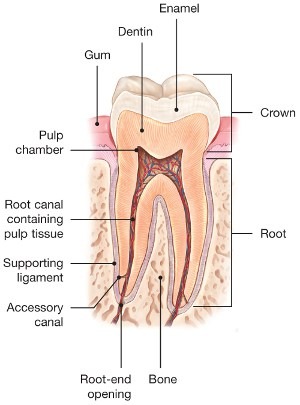
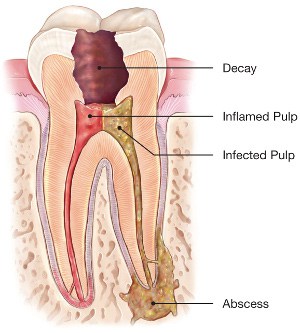
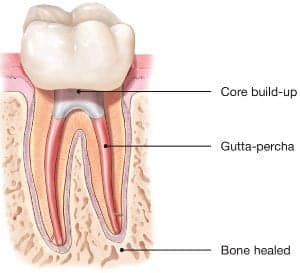
Related: Who is an Endodontist?
What are the various steps of Root canal treatment?
Here’s a brief overview of the root canal treatment steps:
1. Diagnosis:
The dentist will examine the tooth and take x-rays to determine if the pulp inside the tooth is infected or damaged. If the pulp of the tooth is infected or damaged the dentist will advise you to go for root canal treatment.
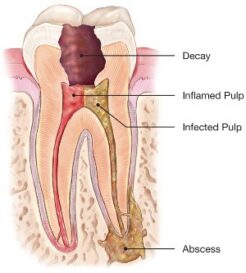
In this image, you can see decay reaching till the pulp and causing infection (abscess) in and around the tooth.
This necessitates the need for root canal treatment in this tooth.
2. Local Anesthesia:
To numb the area, the dentist will apply a local anesthetic to the area around the tooth or sometimes a little behind the tooth to anesthetize the whole area of that side.
3. Isolation:
The dentist will use a rubber dam to isolate the tooth and keep it dry during the procedure. But sometimes the dentist can also avoid using rubber dam to isolate the tooth.
4. Access:
The dentist will make a small opening in the top of the tooth to access the pulp with the help of a dental drill known as an air rotor.
5. Removal of Infected Pulp:
The dentist will remove the infected or damaged pulp using special instruments like dental files.
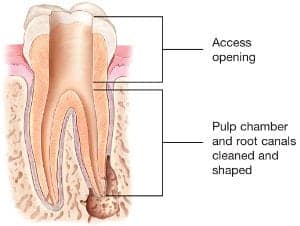
In this image, you can see the top of tooth is cleaned with air rotor to make a access hole through which the canals will be cleaned and filled.
The clean canal system after proper shaping and cleaning.
6. Shaping and Cleaning:
The dentist will shape the root canal to prepare it for filling and cleaning the canal of any remaining debris with some chemicals.
7. Medication:
The dentist may place a temporary filling or medication like metapex or calcium hydroxide in the canal to eliminate any remaining bacteria if needed.
8. Filling:
The dentist will fill the root canal with a rubber-like material to seal it and prevent re-infection.
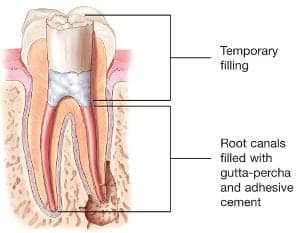
In this image, you can see the roots of teeth are filled with gutta-percha after proper cleaning.
There is a temporary filling on the top for the time being which will be replaced by permanent filling, post and core (if necessary) and crown
9. Post and Core:
The dentist will place a post and core in the tooth to strengthen it if too much tooth structure is lost due to cavity and cleaning. The post is a small metal or fiber post that is inserted into the root canal of a tooth after root canal treatment to provide a secure base for the core. The core is a filling material that is used to build up the tooth and provide a foundation for the crown.
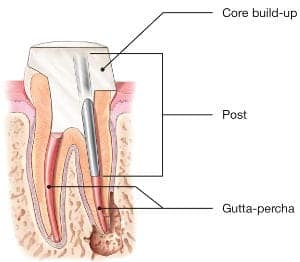
In this image, you can see the metal post in one of the roots of the tooth.
There is core build up done on the post to build the tooth and provide the foundation for the crown.
10. Crown:
The crown is given to strengthen the tooth after the root canal treatment process . Dental crowns can be of various types like porcelain fused to metal (PFM), Ceramic or Zirconia Crowns and your dentist might suggest a different type of crowns based on your need.
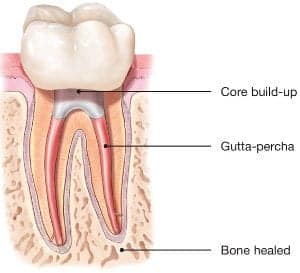
After filling the roots and doing post and core if necessary the crown is given on the top of tooth.
11. Follow-up:
The dentist will schedule a follow-up appointment to ensure that the tooth has healed properly and to assess the need for any additional treatment.
The above steps may vary slightly depending on the tooth and the extent of damage, but these are the general steps involved in a root canal treatment.
What is Manual and Rotary Root canal treatment?
The manual and rotary root canal treatment procedures are two common methods of root canal treatment or endodontic therapy. The main difference between them is the type of instrument used to shape and clean the root canal.
Manual Root Canal Treatment:
- Involves the use of hand files to shape the root canal.
- The dentist manually moves the files back and forth to remove the infected and damaged tissue.
- This method is more time-consuming and requires a high level of manual dexterity from the dentist.
- However, it is considered a more traditional and tried-and-true method that is often used when dealing with complicated cases or in situations where rotary instruments cannot be used.
Rotary Root Canal Treatment:
- Involves the use of rotary instruments, such as nickel-titanium (NiTi) files, to shape the root canal.
- The rotary instruments are driven by a motor, which makes the shaping process quicker and more efficient.
- This method is less time-consuming and less physically demanding for the dentist compared to manual treatment.
- It is also considered more effective in cleaning the root canal, as the rotary instruments are designed to remove debris and bacteria more effectively.
- However, it is important to note that rotary treatment is not always possible, as the shape and anatomy of some root canals may not be suitable for rotary instruments.
In conclusion, both manual and rotary root canal treatments have their advantages and disadvantages. The choice between the two methods depends on the specific case, the dentist’s experience and preference, and the patient’s needs.
Precautions after getting a Root Canal Treatment
Dr. Garima Verma has written a detailed article about the Post Root Canal Treatment Instructions which you can access by clicking the link below:
Need a Root Canal Treatment ?
If you need Root Canal Treatment, you can visit us at 32 Sparklets Dental Implant & Root Canal Center, Mohali or you can also book an appointment by calling +91-9501015088 or +91-9646805088.
Disclaimer:
This blog provides general information about the steps of root canal treatment. The opinion and content on this blog are only for conversational purposes and should not be interpreted as medical or dental advice about any particular individual. If the reader or any other person has a medical or dental concern, he or she should consult with an appropriate licensed medical or dental physician or a health care provider
Image Credits: Most of the images used in this article are taken from the American Association of Endodontists





Pingback: Dental Crowns And Bridges: All You Need To Know - 32 Sparklets | Dentist In Mohali | Best Dentist in Mohali
Pingback: How to treat swollen gums? - DentistMaa
Pingback: Root Canal Treatment : What you need to know !! - 32 Sparklets Dental Implant & Root Canal Center | Dentist In Mohali | Chandigarh
Excellent explanation